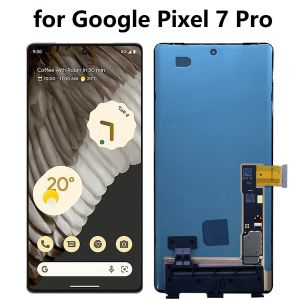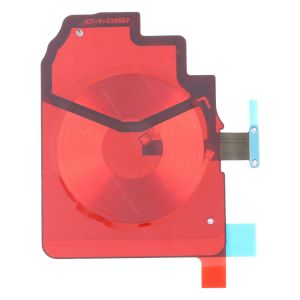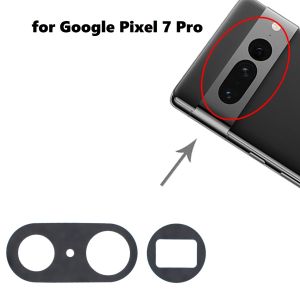Use this guide to replace the screen for your Google Pixel 7 Pro.
For your safety, discharge the battery below 25% before disassembling your phone. This reduces the risk of fire if the battery is accidentally damaged during the repair. If your battery is swollen, take appropriate precautions.
Your new replacement screen will come with the fingerprint reader already attached. If not, you will need to reinstall the original fingerprint reader to your new replacement screen and recalibrate the reader to maintain its functionality.
Caution: The Pixel 7 Pro contains class 1 lasers. Disassembly could result in exposure to invisible infrared laser emissions.
Retaining water resistance after the repair will depend on how well you reapply the adhesive, but your device will lose its IP (Ingress Protection) rating.
You'll need replacement adhesive in order to complete this repair.
Step 1 Loosen the display adhesive
![]()
Completely power off your phone before you begin.
Apply a heated iOpener to the screen to loosen the adhesive underneath. Apply the iOpener for at least 3 minutes.
A hair dryer, heat gun, or hot plate may also be used, but be careful not to overheat the device. The edge should feel slightly too hot to the touch.
Step 2 Screen removal information
The screen of the Google Pixel 7 Pro is held in place by plastic clips and adhesive.
During the removal procedure, make sure to insert your opening picks in the right position to avoid separating the screen from its safety frame.
Only insert the pick up to ~3.5 mm during the removal procedure to avoid damaging the internals and to avoid interfering with the plastic clips.
There are several plastic clips around the whole screen. If your opening pick gets blocked during the screen removal procedure, you've inserted your pick too deep underneath the screen.
Step 3 Anti-Clamp instructions
![]()
The next two steps demonstrate the Anti-Clamp, a tool we designed to make the opening procedure easier. If you aren't using the Anti-Clamp, skip down two steps for an alternate method.
For complete instructions on how to use the Anti-Clamp, check out this guide.
Pull the blue handle towards the hinge to disengage opening mode.
Position the suction cups near the bottom edge of the phone—one on the front, and one on the back.
Push down on the cups to apply suction to the desired area.
If you find that the surface of your device is too slippery for the Anti-Clamp to hold onto, you can use packing tape to create a grippier surface.
Step 4
![]()
Push the blue handle away from the hinge to engage opening mode.
Turn the handle clockwise until you see the cups start to stretch.
Make sure the suction cups remain aligned to each other. If they begin to slip out of alignment, loosen the suction cups slightly and realign the arms.
Wait one minute to give the adhesive a chance to release and present an opening gap.
Insert an opening pick under the screen and its safety frame when the Anti-Clamp creates a large enough gap.
If the Anti-Clamp doesn't create a sufficient gap, apply more heat to the area and rotate the handle clockwise half a turn.
Don't crank more than a half a turn at a time, and wait one minute between turns. Let the Anti-Clamp and time do the work for you.
Skip the next two steps.
Step 5 Insert an opening pick
Once the screen is warm to the touch, apply a suction handle to the bottom edge of the screen.
If your display is badly cracked, covering it with a layer of clear packing tape may allow the suction cup to adhere. Alternatively, very strong tape may be used instead of the suction cup. If all else fails, you can superglue the suction cup to the broken screen.
Lift the screen including its safety frame with the suction handle to create a small gap between the screen and the phone assembly.
Depending on the age of your phone, this may be difficult. If you're having trouble, apply more heat to the bottom edge and try again.
Insert an opening pick into the gap.
Step 6 Slice the bottom edge adhesive
![]()
Slide the opening pick to the bottom right corner of the screen to slice its adhesive.
Leave the opening pick in place to prevent the adhesive from resealing.
Step 7
![]()
Insert a second opening pick at the bottom edge and slide it to the bottom left corner of the screen to slice the adhesive.
Leave the opening pick in place to prevent the adhesive from resealing.
There's a plastic clip in the bottom left corner that will block your opening pick. Only use the tip of the opening pick (~1 mm) to work your way around it.
Step 8 Release the left clips
![]()
Insert a third opening pick underneath the bottom left corner of the screen.
Slide the opening pick along the left edge of the screen to slice the adhesive and to release the plastic clips.
Leave the opening pick in the top left corner to prevent the adhesive from resealing.
Step 9 Slice the top edge adhesive
![]()
If the adhesive becomes hard to cut, it has most likely cooled down. Use your iOpener or heat gun for 1-2 minutes to reheat it.
When you slice near the front facing camera, insert only the tip of the opening pick (~2.5 mm) to avoid damaging or smearing the camera.
Insert a fourth opening pick at the top left corner of the screen.
Slide the opening pick along the top edge of the phone to slice the adhesive.
Leave the opening pick in the top right corner to prevent the adhesive from resealing.
Step 10 Release the right clips
![]()
Insert a fifth opening pick and slide it along the right edge of the phone to slice the remaining adhesive and release the right plastic clips.
Do not try to remove the display all the way yet, the screen is still connected to the phone assembly by a flex cable.
Step 11 Open up the phone
Lift the right edge of the screen up and towards the left side of the device, like opening a book.
Don't twist the screen or move it too far away from the frame to avoid straining or damaging the flex cable.
Rest the screen upside down and parallel to the frame.
Step 12 Release the display cable bracket
![]()
The display cable bracket sits tightly and requires some force to release it.
Insert one arm of a pair of tweezers into the opening at the upper end of the display cable bracket.
Push the bracket inwards and pry up to release it.
Step 13 Remove the display cable bracket
![]()
Use a pair of tweezers to remove the display cable bracket by pulling it from underneath the midframe and in direction of the camera.
Step 14 Disconnect the display cable
Use a spudger to disconnect the display flex cable by prying the connector straight up from its socket.
To re-attach press connectors like this one, carefully align and press down on one side until it clicks into place, then repeat on the other side. Do not press down on the middle. If the connector is misaligned, the pins can bend, causing permanent damage.
Step 15 Separate the screen
Separate the screen from the phone assembly.
During reassembly, apply new adhesive where it's necessary after cleaning the relevant areas with isopropyl alcohol (>90%).
Follow this guide if you're using custom-cut adhesives for your device.
Follow this guide in case you're using a pre-cut adhesive card.
If your replacement screen's display cable is held down by tape, remove the tape before installation.
Be sure to remove all adhesive liners from your replacement screen. Check the selfie camera recess and make sure you've removed the liner there.
During the boot-up process after reassembly, the screen will go through a calibration sequence. Do not touch the screen during this process, as it could result in improper touch calibration and create touch issues.
CONCLUSION
If possible, turn on your device and test your repair before installing new adhesive and resealing.
To reassemble your device, follow these instructions in reverse order.
The best way to secure the new screen is to apply a sheet of custom-cut double-sided tape to the frame and place the screen back in its original position.










